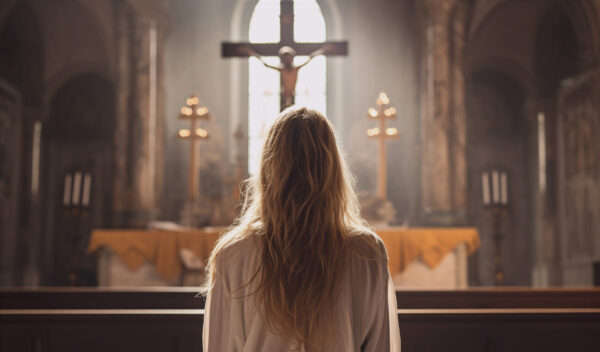This is the latest installment of the series, “The genius of my sister.” Read other articles in the series to learn more about Catholic women throughout history and how they can inspire us today.
How I would like to meet my sister, St. Kateri Tekakwitha — the first Indigenous woman to be canonized. How I would like to sit in the presence of her genius, to listen to her stories, to ask her what she would say to our Church today.
For many people, the life of St. Kateri serves as a beautiful story of hope and courage, or the merging of two cultures — Native American and Roman Catholic. (Her name alone signifies this reality: Kateri being the Iroquois pronunciation of her baptismal name, which means Catherine; Tekakwitha being her Iroquois name, meaning “one who bumps into things.”) For others, it is a difficult story to accept, due to the reality that many European colonists sought to conquer land and, in turn, Native Americans — as well as the fact that some missionaries failed the Body of Christ by forcing Indigenious people to convert to Christianity. To justly tell the story of St. Kateri, we cannot entirely ignore the latter.
Want more Radiant? Sign up for our weekly newsletter!
It is true, from the writings of the Jesuit missionaries, that we can gather that the Jesuits truly tried to understand and respect the culture of Native Americans (though they were originally unwelcomed), even if in retrospect we can acknowledge ways in which they could have done better. It appears that Kateri was loved and welcomed by the Jesuit missionaries, that Catholicism was not forced upon her, that she was encouraged to retain aspects of her heritage, and that she became a leader for her people. It is also true that we do not have any firsthand accounts from Kateri herself. Our task, then, is to hold all of these realities in tension.
In 1656, in the Mohawk Valley of what is now New York, Tekakwitha was born to her mother, a Christian Algonquin (rare at that time), and her father, a Mohawk chief. At the age of four, Tekakwitha’s parents both died of smallpox. Though Tekakwitha survived the disease, she was left nearly blind and with scars all over her body. She was brought into the home of her uncle, who would in time become the chief. Despite being orphaned at such a young age, Tekakwitha’s mother had already instilled in her daughter a love of Jesus.
At the age of 11, Tekakwitha encountered the Jesuits, who up until this point had had an extremely tumultuous relationship with the Mohawks. Her interactions with the Jesuits were frowned upon, but as the Jesuits’ influence in the community grew, so did Tekakwitha’s love of Christ and interest in Catholicism. Several years later, her aunt and uncle made arrangements for Tekakwitha to be married, as was custom for their culture, but she refused. Instead, to the shock and disappointment of her tribe and family members, she requested to be baptized Catholic — for more than anything, she longed to be one with Christ.
At the age of 23, on March 25, 1679 (the feast of the Annunciation), Kateri, having received the Eucharist, vowed to live as a bride of Christ, as a virgin, forever. Father Cholenec, a priest who knew Kateri, wrote that she said: “I have deliberated enough. For a long time my decision on what I will do has been made. I have consecrated myself entirely to Jesus, son of Mary, I have chosen him for husband and he alone will take me for wife.” She lived a life of spiritual asceticism (often practicing self-flagellation). Less than a year later, Kateri became ill and died on April 17, 1680. According to the writings of Father Cholenec, her last words were “Jesus, Mary.” She entered into eternal life at the age of 24.
To honor and admire the life of St. Kateri, we must prevent ourselves from using her as a “token” Native American saint. Rather, we must be inspired by her life of faith to be countercultural and to seek Jesus at all costs, even when others do not understand, and especially to ask for her intercession to help us become the Church she believed in.




